新版人教版新目标九年级英语Unit+12全套教案
- 格式:docx
- 大小:56.03 KB
- 文档页数:19

新版人教版新目标九年级英语unitunit
12-5教案
新版人教版新目标九年级英语unit 12-5教案
教学目标
- 学生通过本节课的研究,能够掌握与旅游相关的词汇,如旅行目的地、交通方式、旅行活动等。
- 学生能够运用所学的词汇和句型,描述自己的旅行计划。
教学重点
- 词汇:目的地、交通方式、旅行活动等。
- 句型:我打算去...;我想坐...去...。
教学准备
- 教材:新版人教版新目标九年级英语教材Unit 12-5部分
- 多媒体设备:投影仪、音频设备等
教学过程
导入(5分钟)
- 利用图片或视频引入旅游的话题,激发学生的研究兴趣。
概念理解(10分钟)
- 呈现目的地、交通方式等词汇的图片或卡片,并与学生一起复和研究相关词汇。
- 利用问题和例句帮助学生理解词汇的用法和意义。
例句模仿(15分钟)
- 提供一些与旅游相关的情景,让学生利用所学词汇和句型进行模仿和练。
- 引导学生使用第一人称表达自己的旅行计划,并与同学一起分享。
练巩固(15分钟)
- 在课堂上设计一些小组活动或游戏,让学生以小组形式进行练和巩固所学内容。
- 鼓励学生积极参与,提高口语表达和合作能力。
作业布置(5分钟)
- 布置相关的作业,如写一篇关于自己旅行计划的短文或制作旅行计划的海报等。
教学延伸
- 鼓励学生展示自己的旅行经历和心得体会,促进彼此之间的交流和分享。
- 引导学生研究关于旅游的文化知识和俗,增加跨文化的理解和认知。
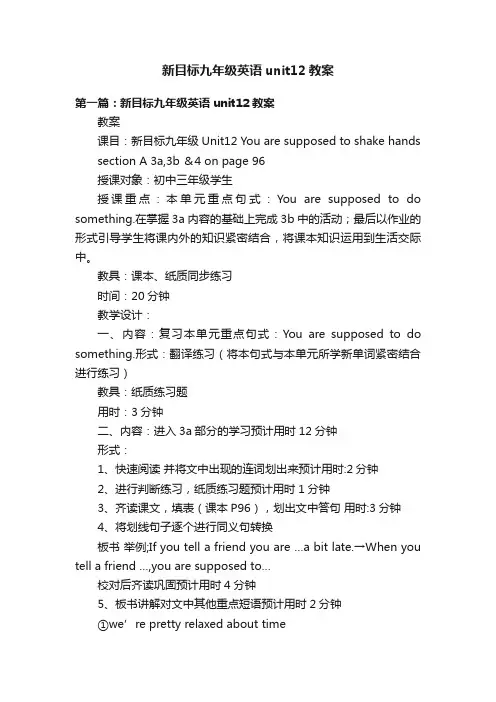
新目标九年级英语unit12教案第一篇:新目标九年级英语unit12教案教案课目:新目标九年级Unit12 You are supposed to shake hands section A 3a,3b &4 on page 96授课对象:初中三年级学生授课重点:本单元重点句式:You are supposed to do something.在掌握3a内容的基础上完成3b中的活动;最后以作业的形式引导学生将课内外的知识紧密结合,将课本知识运用到生活交际中。
教具:课本、纸质同步练习时间:20分钟教学设计:一、内容:复习本单元重点句式:You are supposed to do something.形式:翻译练习(将本句式与本单元所学新单词紧密结合进行练习)教具:纸质练习题用时:3分钟二、内容:进入3a部分的学习预计用时12分钟形式:1、快速阅读并将文中出现的连词划出来预计用时:2分钟2、进行判断练习,纸质练习题预计用时1分钟3、齐读课文,填表(课本P96),划出文中答句用时:3分钟4、将划线句子逐个进行同义句转换板书举例;If you tell a friend you are …a bit late.→When you tell a friend …,you are supposed to…校对后齐读巩固预计用时4分钟5、板书讲解对文中其他重点短语预计用时2分钟①we’re pretty relaxed about time②Spending time with family and friends is ve ry important to us.③drop by our friends’ homes.④ make plans to meet our friends.⑤walk around the town center,⑥seeing as many of our friends as we can!三、内容:3b pair work形式:填空练习,校对,齐读教具:纸质练习用时:3分钟四、内容:part4,page96形式:布置作业;结合生活情境填表,然后将各个句子改成You are supposed todo something.的形式。
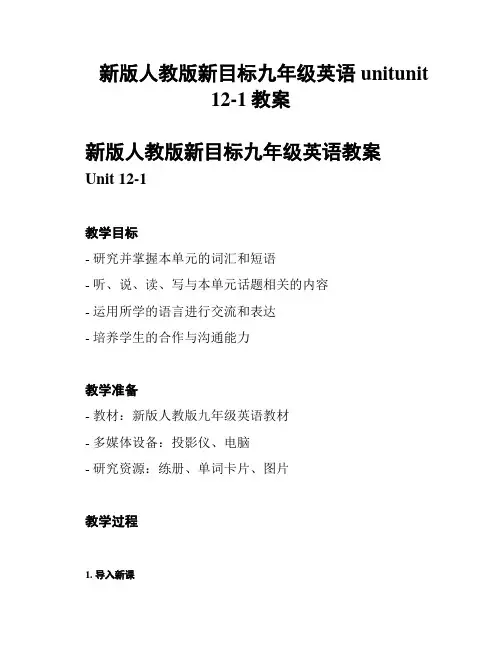
新版人教版新目标九年级英语unitunit12-1教案新版人教版新目标九年级英语教案Unit 12-1教学目标- 研究并掌握本单元的词汇和短语- 听、说、读、写与本单元话题相关的内容- 运用所学的语言进行交流和表达- 培养学生的合作与沟通能力教学准备- 教材:新版人教版九年级英语教材- 多媒体设备:投影仪、电脑- 研究资源:练册、单词卡片、图片教学过程1. 导入新课- 通过展示相关图片和单词卡片,引出本单元的话题:“旅行”。
2. 温故知新- 让学生回顾并复上一单元的相关内容,引出本单元的新词汇和短语。
3. 研究新知- 逐步介绍本单元的新词汇和短语,通过图片和例句的形式帮助学生理解和记忆。
4. 听说训练- 播放录音,让学生跟读并模仿语音语调。
- 通过小组活动和角色扮演,让学生运用所学语言进行对话练。
5. 读写训练- 学生朗读课文并展示理解。
- 分组进行阅读理解练,学生互相提问和回答问题。
- 写作练:要求学生根据所学内容,写一篇与旅行相关的短文。
6. 练与巩固- 练册相关练,巩固所学知识点。
- 小组活动:让学生在小组内编写一个模拟旅行的对话,并进行表演。
7. 总结与反思- 回顾本课所学内容,进行总结和复。
- 让学生分享他们对本单元的理解和研究体会。
教学评价- 观察学生的参与度和表现,进行口头评价。
- 收集并批改学生的书面作业,并给予指导和反馈。
- 学生小组表演和讨论的观察评价。
拓展延伸- 布置一些与旅行相关的项目作业,鼓励学生开展实际调查和研究。
- 鼓励学生使用所学语言进行真实情境的交流和表达。
参考资料- 新版人教版九年级英语教材- 练册- 多媒体资源。
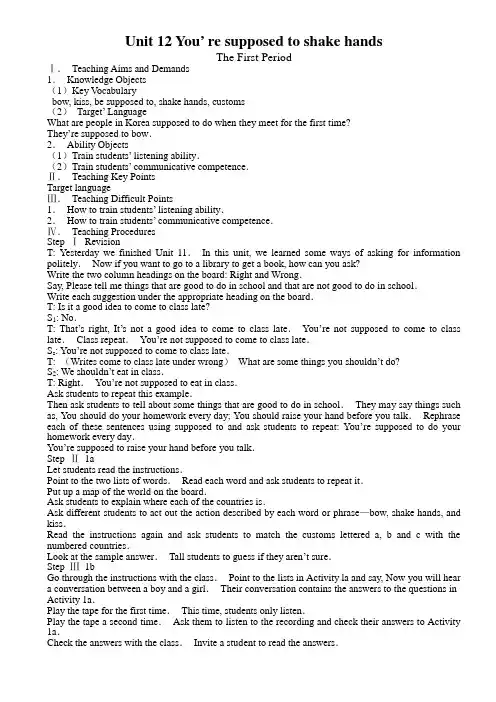
Unit 12 You’ re supposed to shake handsThe First PeriodⅠ.Teaching Aims and Demands1.Knowledge Objects(1)Key V ocabularybow, kiss, be supposed to, shake hands, customs(2)Target’ LanguageWhat are people in Korea supposed to do when they meet for the first time?They’re supposed to bow.2.Ability Objects(1)Train students’ listening ability.(2)Train students’ communicative competence.Ⅱ.Teaching Key PointsTarget languageⅢ.Teaching Difficult Points1.How to train students’ listening ability.2.How to train students’ communicative competence.Ⅳ.Teaching ProceduresStep ⅠRevisionT: Yesterday we finished Unit 11.In this unit, we learned some ways of asking for information politely.Now if you want to go to a library to get a book, how can you ask?Write the two column headings on the board: Right and Wrong.Say, Please tell me things that are good to do in school and that are not good to do in school.Write each suggestion under the appropriate heading on the board.T: Is it a good idea to come to class late?S1: No.T: That’s right, It’s not a good idea to come to class late.You’re not supposed to come to class late.Class repeat.You’re not supposed to come to class late.S s: You’re not supposed to come to class late.T: (Writes come to class late under wrong)What are some things you shouldn’t do?S2: We shouldn’t eat in class.T: Right.You’re not supposed to eat in class.Ask students to repeat this example.Then ask students to tell about some things that are good to do in school.They may say things such as, You should do your homework every day; You should raise your hand before you talk.Rephrase each of these sentences using supposed to and ask students to repeat: You’re supposed to do your homework every day.You’re supposed to raise your hand before you talk.Step Ⅱ1aLet students read the instructions.Point to the two lists of words.Read each word and ask students to repeat it.Put up a map of the world on the board.Ask students to explain where each of the countries is.Ask different students to act out the action described by each word or phrase—bow, shake hands, and kiss.Read the instructions again and ask students to match the customs lettered a, b and c with the numbered countries.Look at the sample answer.Tall students to guess if they aren’t sure.Step Ⅲ1bGo through the instructions with the class.Point to the lists in Activity la and say, Now you will hear a conversation between a boy and a girl.Their conversation contains the answers to the questions in Activity 1a.Play the tape for the first time.This time, students only listen.Play the tape a second time.Ask them to listen to the recording and check their answers to Activity 1a.Check the answers with the class.Invite a student to read the answers.Step Ⅳ1cRead the instructions to the whole class.Point out the example in the box.Ask two students to read it to the class.Point to the lists of customs and countries in Activity la.Tell students to first talk about these countries and customs, and then talk about other countries and customs they know about.As students work together, move around the classroom checking their work.Ask different pairs of students to ask and answer a question for the class.Step ⅤHomeworkReview the target language.The Second PeriodⅠ.Teaching Aims and Demands1.Knowledge Objects(1)Key V ocabularygreet, be supposed to(2)Target LanguageHow was the dinner at Paul’s house last night?Well, it was OK, but I made some mistakes.I was supposed to arrive at 7:00, but I arrived at 8:00.2.Ability Objects(1)Train students’ listening ability.(2)Train students’ communicative competence.3.Moral ObjectsWhen you’re invited to a place, you mustn’t be late, greet people the wrong way and wear the wrong clothes.That is, you should act according to your host’s customs.Ⅱ.Teaching Key Points1.Key V ocabularygreet, be supposed to2.Target LanguageHow was the dinner at Paul’s house last night?Well, it was OK, but I made some mistakes.I was supposed to arrive at 7:00, but I arrive at 8:00.3.StructureWhat are you supposed to do when you meet someone?Ⅲ.Teaching Difficult Points1.the target language2.How to improve students’ listening ability.Ⅳ.Teaching ProceduresStep ⅠRevisionCheck homework.Ask some pairs to act out their conversations according to Activity 1a.Step Ⅱ2aLook at the picture and ask students to tell What is happening.Help students understand that the people are at a picnic.Point to Maria and ask, what’s Maria wearing? (She is wearing a dress.)Ask, Does she look comfortable? (No.)Read the instructions and point to the four mistakes on the list.Ask different students to read the mistakes to the class.Listen to Maria talking to a boy about what happened at the picnic.She made several mistakes.Listen to the recording and check the mistakes she made.Play the recording.Students only listen the first time.Play the recording again.Get students to check the mistakes Maria made.Check the answers with the class.Step Ⅲ2bGo through the instructions with the class.Point out the blanks in the four sentences.Invite a student to read the first sentence.Play the recording again.Let students fill in the blanks with the words they hear alone.Correct the answers with the class.Step Ⅳ2cRead the instructions for the activity to the class.Look at the example in the box.Ask two students to read the conversation to the class.Point out the mistakes in Activity 2a and the sentences in Activity 2b.Role play Dan and Maria’s conversation using information from Activities 2a and 2b.Ask students to work in pairs.As they work, move around the classroom checking the progress of the pairs and offering help as needed.Check the answers by calling on different pairs to say their conversations to the class.Step ⅤGrammar FocusReview the grammar box.Get different students to say the questions and answers.Step ⅥHomeworkAsk students to write at least two sentences with the sentence starters in Grammar Focus.The Third PeriodⅠ.Teaching Aims and Demands1.Knowledge Objects(1)Key V ocabularyland, drop by, after all, relaxed, a bit(2)Target LanguageCan you tell me the things I’m supposed to do?The first thing is to greet the teacher.Okay.What should I say?You are supposed to say "good morning, teacher."2.Ability Objects(1)Train students’ integrating skills.(2)Train students’ communicative competence.Ⅱ.Teaching Key PointTrain students’ integrating skills.Ⅲ.Teaching Difficult PointHow to improve students’ integrating skills.Ⅳ.Teaching ProceduresStep ⅠRevisionT: In last period, we summed up the expressions for telling what you are supposed to do.Now I’ll check your homework.I’ll ask some pairs to act out the conversations before the class.Step Ⅱ3aRead the instructions.Do you know what an opinion is?Ask a student to answer it.(An opinion is what you think or how you feel about something.)Look at the chart.Point to the word attitude on the chart and say, An opinion is like an attitude.Tell students what they will write in the chart.Ask students to read the first paragraph on their own.When they read, move around the classroom helping them as necessary.Then ask students to read the second paragraph.Again, as they read, move around the classroom answering any questions.Then read the instructions again and point out the chart.Point to the words attitude toward and ask what other words in the instruction line mean the same thing(opinions of).Invite a student to read the sample answer to the class.Then let him point out which sentence the answer is found in.Ask students to read the paragraphs again and complete the chart on their own.Correct the answers with the class.Step Ⅲ3bGo through the instructions for the activity with the class.Look at the example in the box.Ask two students to read the conversation to the class.First practice this conversation with a partner.Then talk about your attitude toward being on time and getting together with your friends.Use true information.Have students work in pairs.Ask some different pairs to say their conversations to the class.Step ⅣPart 4Let students read the instructions.Ask a pair of students to model the sample dialogue.Correct any pronunciation errors to make sure the students are providing a good model for the rest of the class.Get students to complete the work in pairs.As they work, walk around the classroom offering help as needed.Review the task.Ask a few students to share their conversations with the whole class.Step ⅤHomework1.Write a conversation using the information in Part 4.2.Finish off the exercises on pages 49~50 of the workbook.The Fourth PeriodⅠ.Teaching Aims and Demands1.Knowledge Objects(1)Key V ocabularywipe, napkin, stick, chopstick, rude, point, pick up(2)Target LanguageWe’re supposed to eat with chopsticks.Yes, and it’s rude to eat with our hands.2.Ability Objects(1)Train students’ listening ability.(2)Train students’ ability to understand the target language in spoken conversation.(3)Train students’ ability to use the target language.Ⅱ.Teaching Key Points1.Key V ocabularywipe, stick, chopstick, rude, point, pick up2.Target LanguageWe’re supposed to eat with chopsticks.Yes, and it’s rude to eat with our hands.Ⅲ.Teaching Difficult Points1.Flow to improve students’ listening ability.2.How to use the target language.Ⅳ.Teaching ProceduresStep ⅠRevisionCheck homework.Get some students to read out their conversations using the target language in Section A 4.Collect their conversations and help correct their errors.Step ⅡPart 1Look at the picture and ask students to say what is happening in it.Look at the title, Mind your manners!Ask.What do you think it might mean?Read the instructions and point to the five statements about manners.Ask students to read the statements.Review the five statements to be sure students understand what each one means.Ask students to act out them.Then ask students to complete the quiz on their own.Correct the answers with the class.Step Ⅲ2aRead the instructions to the class.Review what an exchange student is and what table manners are.If necessary, translate them into Chinese.Look at the four pictures.You will hear the exchange student Steve, talking with his Japanese friend, Satoshi.Satoshi is explaining some things you are and aren’t supposed to do when eating in Japan.Point to the boxes where students are supposed to write a number next to each picture.Say, Number these 1 through 4 to show the order you hear Satoshi talk about, these things in the recording.Play the recording the first time.Students only listen.Play the recording a second time.As they listen to the recording this time, let students number the pictures.Correct the answers with the class.Step Ⅳ2bRead the instructions and point to the numbered list of sentence starters and the lettered list of sentence endings.Ask different students to read the two lists.You will hear the same recording again.Play the recording again.Ask students to write the letters in the blanks alone.Check the answers with the class.Step Ⅴ2cGo through the instructions for the activity with the class.Look at the example in the box.Ask two students to read the sentence starters.Now, complete each one with a true statement about table manners in your country.Ask two students to read their sentences.Point out the sentence starters in Activity 2b.Say, Have a conversation about table manners in your country with a patter.You can use the sentence starters in Activity 2b to help you get started.Have students work in pairs.Ask one or two pairs of students to say their conversations to the class.Step ⅥHomeworkTalk about the table manners in your country using the sentence starters inActivity 2b.The Fifth PeriodⅠ.Teaching Aims and Demands1.Knowledge Objects(1)Key V ocabularytable manners, behave, be/get used to, cut up, full, fork, You should…(2)Practise reading an article.(3)Practise writing something using the target language.2.Ability Objects(1)Train students’ reading ability.(2)Train students’ writing ability.Ⅱ.Teaching Key PointPractise reading and writing using the target language.Ⅲ.Teaching Difficult PointHow to write an e-mail message.Ⅳ.Teaching ProceduresStep ⅠRevisionReview the target language presented in this unit.Check homework.Ask two students to read out their sentences.Step Ⅱ3aCall attention to the e-mail message.Invite a student to read the article aloud to the class.Correct any pronunciation errors to make sure the student is providing a good model for the rest of the class.Read the instructions to the class.Ask students to read the e-mail again.Say,Now read the e-mail.Answer the questions in your exercise book.As students work, move around the classroom and offer help as necessary.Check the answers with the class.Step Ⅲ3bRead the instructions to the class.Point to the beginning of the e-mail message.Read it to the class.Here are some things you need to know about table manners when you visit Japan.First of all, you should…Look back at the pictures in Activity 2a and the matching exercise in Activity 2b.You can use the pictures and information in Activities 2a and 2b to help you write your letters.Ask students to finish the activity on their own.As they work, walk around the classroom offering help and answering questions as needed.Check the answers with the class.Ask a student to read his completed article to the class.Step Ⅳ3cRead the instructions and ask students to look back at Activity 2c.Remind students that they made conversations about table manners in their own country.Say.You can use the ideas you talked about in Activity 2c as you write your email messages.Get students to finish the activity on their own.As students work, move around the room offering help as needed.Ask a student to read his or her message to the class.Have other students add any information that is missing from the first student’s report.Step ⅥHomework1.Read the e-mail message in Activity 3a again.2.Write an e-mail message to a friend about table manners.The Sixth PeriodⅠ.Teaching Aims and Demands1.Knowledge Objects(1)Fill in blanks and make sentences using arrive, meet, spend, behave and imagine.(2)Finish the story.(3)Complete the crossword.2.Ability ObjectsTrain students’ writing ability.3.Moral ObjectsYou are supposed to learn much more table manners, It is very useful and helpful, especially when you are in foreign countries.Ⅱ.Teaching Key Points1.Fill in blanks and make sentences.2.Finish the story.Ⅲ.Teaching Difficult Points1.Make sentences using arrive, meet, spend, behave and imagine.2.Finish the story.Ⅳ.Teaching ProceduresStepⅠRevisionCheck homework.Ask a student to read the e-mail message in Activity 3a.Then ask a student to read his/her own e-mail message.StepⅡPart 1Look at the words in the box.Ask a student to read them.Make sure students understand the meaning of the words.Then say, Fill in the blanks with the words.In some cases, students may need to use another form of the word, for example adjusting for tense or subject/verb agreement.Ask students to fill in the blanks on their own.Check the answers.Five students each read a sentence, filling in the blanks.The rest of the students check their answers.Ask students to make their own sentences with the words, preferably sentences that are meaningful.Move around the classroom.Collect a few students’answers with mistakes on the blackboard.Then help students correct the mistakes.Step ⅢPart 2Go through the instructions with the class.Explain them to students.Get students to complete the work in pairs.Invite a few students to read the end of the story.Answers will vary but will probably include watching what others do first or asking the host or hostess or one of the guests.A sample end of the story…What I finally decided to do was to watch what others do and follow them.Step ⅣPart 3Do the example with the class to show them how to do a crossword puzzle.Ask students to complete the crossword puzzle on their own.Check the answers with the whole class.Step ⅤJust for Fun!This activity provides reading and speaking practice with the target language.Ask students what is funny about the cartoon.Help students to explain.The little boy bought his grandmother a cat instead of a hat, but his grandmother loves it anyway.Step ⅥSummary and HomeworkIn this class, we’ve done much writing practice using the key vocabulary words.After class, please finish off the story in 2 in your textbooks.Then finish off the exercises on pages 50~52 of the workbook.The Seventh PeriodⅠ.Teaching Aims and Demands1.Knowledge ObjectsKey V ocabularydie, succeed, sacrifice, path, honor, dead-end road, get into trouble, give up, keep shipping, military school2.Ability ObjectsImprove students’ reading and writing skills.Ⅱ.Teaching Key PointTrain students’ reading and writing skills.Ⅲ.Teaching Difficult PointTrain students’ reading and writing skills.Ⅳ.Teaching ProceduresStep ⅠKey V ocabularyShow the following vocabulary by cards.Careful-reading to get the detailed information.Say the words and have students repeat them again and again until they can pronounce them fluently and accurately.Step ⅡPart 1Read the title Parent helps child to the class.Ask, What do you think the article is about, based on the title?Look at the picture.Ask students to describe what is happening in the picture.Ask students to discuss the four questions.Students do not look at the reading text.Instead, they use their background knowledge to try to answer the questions.As they work, walk around, looking at their progress.When most students finish the task, ask students to compare their answers with a partner,Elicit answers from the students.Ask, Do you have any other answers? Do not give the correct answers to the students at this point.Wait until students have finished the reading and let them revise their answers accordingly.Step ⅢPart 2Go through the instructions with the class.Ask students to complete the task individually or in pairs.Make sure students discuss their reasons in English.As they work, walk around the classroom offering help as necessary.Ask students to read their answers.Encourage students to use complete sentences.Step ⅣPart 3Look at the story.Pay attention to the words indicated in bold.Ask different students to guess the meaning.Don’t give them the correct answers.Ask students to read the article once.Say, Pay attention to the bold words and expressions.And note any other words or sentences you don’t understand.Read in context, guessing the meanings of words and phrases from the other words around them.Ask students to read’ the article again for comprehension.Go through the instructions with the students and have them look at the example.Ask students to complete the next word on the list on the left.Students are matching words to meanings.As they work, walk around the classroom offering help as necessary.Students complete the task.Remind them to look at the story again for extra help.Have students report their answers.Encourage them to use complete sentences.Step ⅤPart 4Go through the task with students.Elicit the first answer from students from memory.Check that they understand what they need to do.Ask students to do the activity on their own or in pairs.Students should try to remember or guess theanswers before looking at the reading.As they work, walkaround the classroom offering help students may need.Check the answers.Invite different students to give their answers and give the correct statements for the ones that are false.Step ⅥPart 5Read the instructions with the students.Divide the class into small groups to do the activity.Give students help thinking of different fun and educational activities.Walk around the classroom offering help as needed.Cheek the answers.Have students share their answers with the class.StepⅦSummaryIn this class, we’ve practised a lot of reading and writing.Step ⅧHomework1.Read the story in Activity 2 again for further comprehension.2.Revise the target language in this unit.。
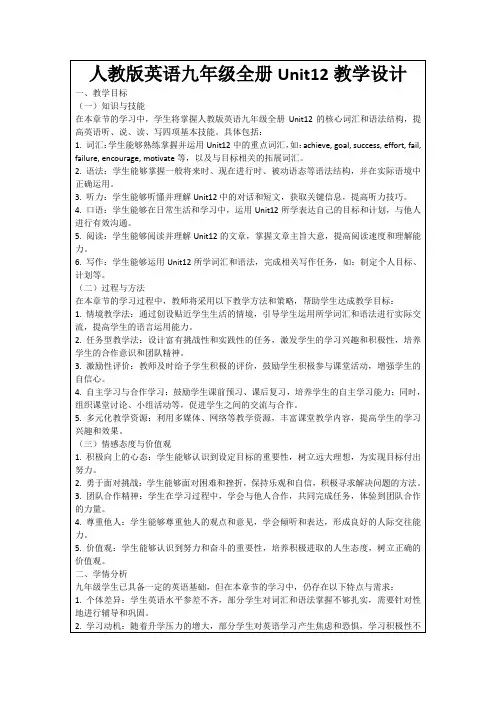
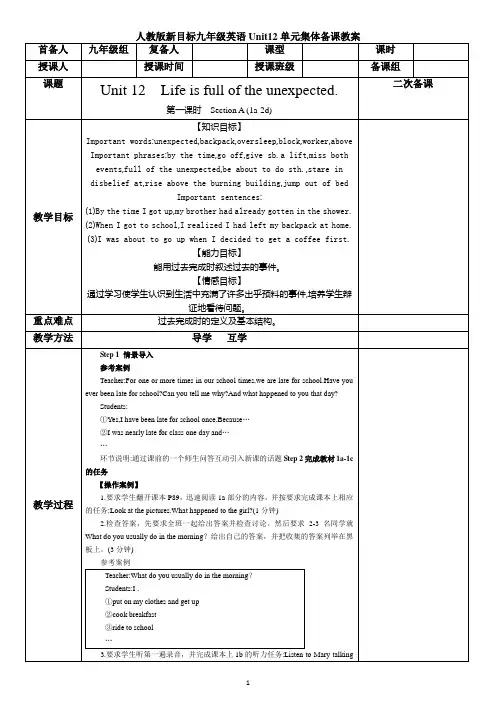
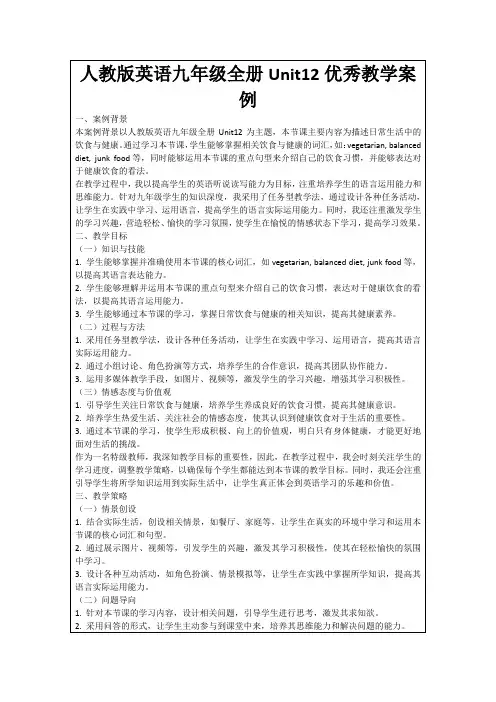
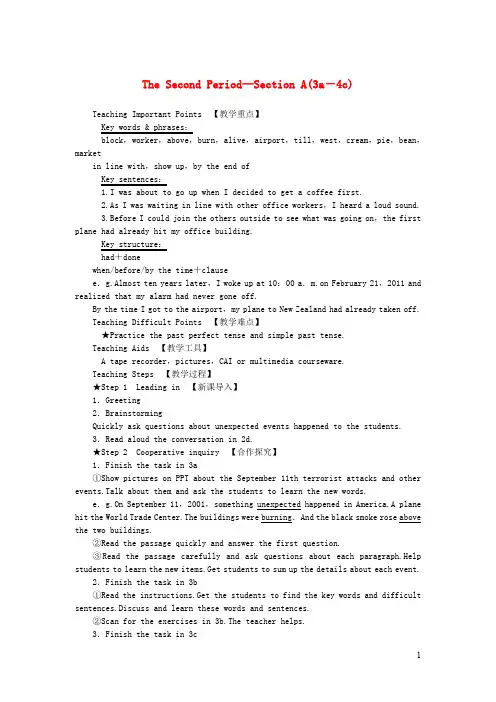
The Second Period—Section A(3a-4c)Teaching Important Points 【教学重点】Key words & phrases:block,worker,above,burn,alive,airport,till,west,cream,pie,bean,marketin line with,show up,by the end ofKey sentences:1.I was about to go up when I decided to get a coffee first.2.As I was waiting in line with other office workers,I heard a loud sound.3.Before I could join the others outside to see what was going on,the first plane had already hit my office building.Key structure:had+donewhen/before/by the time+clausee.g.Almost ten years later,I woke up at 10:00 a.m.on February 21,2011 and realized that my alarm had never gone off.By the time I got to the airport,my plane to New Zealand had already taken off.Teaching Difficult Points 【教学难点】★Practice the past perfect tense and simple past tense.Teaching Aids 【教学工具】A tape recorder,pictures,CAI or multimedia courseware.Teaching Steps 【教学过程】★Step 1 Leading in 【新课导入】1.Greeting2.BrainstormingQuickly ask questions about unexpected events happened to the students.3.Read aloud the conversation in 2d.★Step 2 Cooperative inquiry 【合作探究】1.Finish the task in 3a①Show pictures on PPT about the September 11th terrorist attacks and other events.Talk about them and ask the students to learn the new words.e.g.On September 11,2001,something unexpected happened in America.A plane hit the World Trade Center.The buildings were burning.And the black smoke rose above the two buildings.②Read the passage quickly and answer the first question.③Read the passage carefully and ask questions about each paragraph.Help students to learn the new items.Get students to sum up the details about each event.2.Finish the task in 3b①Read the instructions.Get the students to find the key words and difficult sentences.Discuss and learn these words and sentences.②Scan for the exercises in 3b.The teacher helps.3.Finish the task in 3c①Read the words and expressions in 3c.Get the students to retell the story in the groups.②Ask some students to retell the story to the whole class.Show some sentences on the board to help.③Safety education.Teach them how to save themselves or escape to safety when meeting with accident.3.Finish Grammar Focus①Read aloud the sentences in the grammar frame until fluently.Find the sentences in different tenses.②Discuss the two past pare them with each other and learn how to use them.③The teacher gives more sentences as examples.Get the students to sum up and learn the tenses.Teach the structures and their usage.Remind the students of the verbs and the order of the two actions.Practice some sentences.4.Finish the task in 4a①Students make full sentences on their own,the teacher reminds them of the tenses.②Get the students to check in pairs and then in class.5.Finish the task in 4b①Read the verbs and phrases in the box in 4b.Then ask individual student to write their past forms and past participle forms.②Students fill in the blanks on their own.③Ask students to say out the full sentences to the class.Ask them why they fill those.6.Finish the task in 4c①Show the half sentences and ask different students to say their sentences.Make as many sentences as they can.②Get the students to write two true sentences and one imaginary sentences.Ask some to read out their sentences.Let others tell which is imaginary.Tell the reasons.★Step 3 Homework1.Tell about their unexpected events.Prepare for report in the next class.2.Write a short story to tell about an unexpected thing.3.Translate the following sentences into English.(1)我到达车站时,发现我把身份证丢家里了。
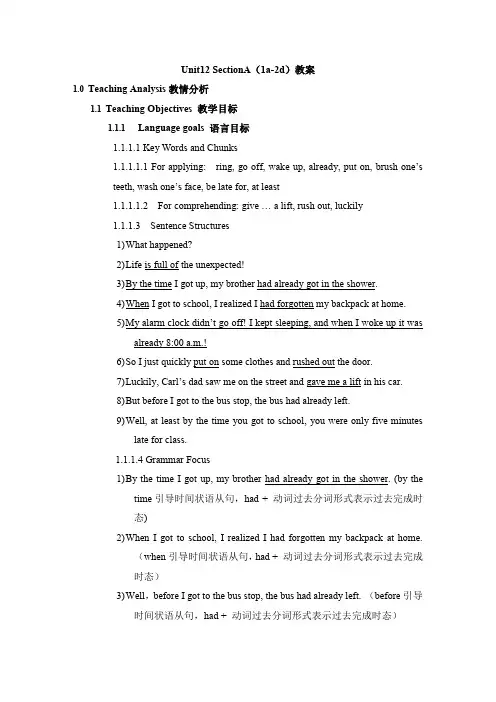
Unit12 SectionA(1a-2d)教案1.0Teaching Analysis教情分析1.1Teaching Objectives 教学目标1.1.1Language goals 语言目标1.1.1.1 Key Words and Chunks1.1.1.1.1 For applying: ring, go off, wake up, already, put on, brush one’steeth, wash one’s face, be late for, at least1.1.1.1.2 For comprehending: give … a lift, rush out, luckily1.1.1.3 Sentence Structures1)W hat happened?2)L ife is full of the unexpected!3)B y the time I got up, my brother had already got in the shower.4)W hen I got to school, I realized I had forgotten my backpack at home.5)M y alarm clock didn’t go off! I kept sleeping, and when I woke up it wasalready 8:00 a.m.!6)S o I just quickly put on some clothes and rushed out the door.7)L uckily, Carl’s dad saw me on the street and gave me a lift in his car.8)B ut before I got to the bus stop, the bus had already left.9)W ell, at least by the time you got to school, you were only five minuteslate for class.1.1.1.4 Grammar Focus1)B y the time I got up, my brother had already got in the shower. (by thetime引导时间状语从句,had + 动词过去分词形式表示过去完成时态)2)W hen I got to school, I realized I had forgotten my backpack at home.(when引导时间状语从句,had + 动词过去分词形式表示过去完成时态)3)W ell,before I got to the bus stop, the bus had already left. (before引导时间状语从句,had + 动词过去分词形式表示过去完成时态)1.1.2Ability goals 能力目标1.1.2.1 学会用when/ by the time引导时间状语从句,用“had+动词过去分词形式”谈论过去的事情。
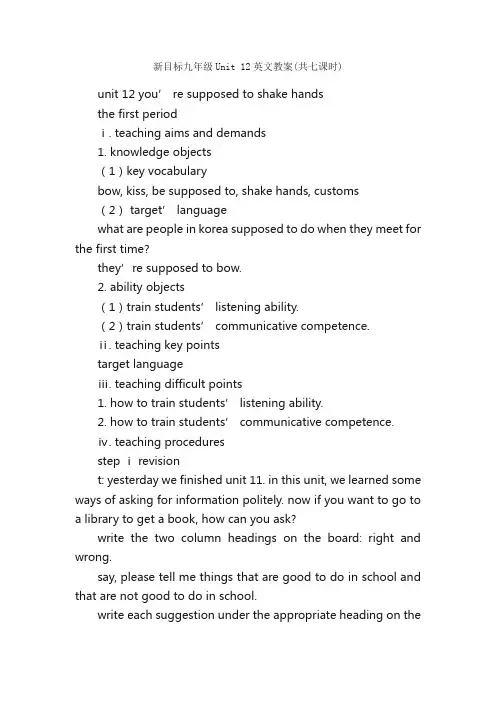
新目标九年级Unit 12英文教案(共七课时)unit 12 you’ re supposed to shake handsthe first periodⅰ. teaching aims and demands1. knowledge objects(1)key vocabularybow, kiss, be supposed to, shake hands, customs(2)target’ languagewhat are people in korea supposed to do when they meet for the first time?they’re supposed to bow.2. ability objects(1)train students’ listening ability.(2)train students’ communicat ive competence.ⅱ. teaching key pointstarget languageⅲ. teaching difficult points1. how to train students’ listening ability.2. how to train students’ communicative competence.ⅳ. teaching proceduresstep ⅰ revisiont: yesterday we finished unit 11. in this unit, we learned some ways of asking for information politely. now if you want to go to a library to get a book, how can you ask?write the two column headings on the board: right and wrong.say, please tell me things that are good to do in school and that are not good to do in school.write each suggestion under the appropriate heading on theboard.t: is it a good idea to come to class late?s1: no.t: that’s right, it’s not a good idea to come to class late. you’re not supposed to come to class late. class repeat. you’re not supposed to come to class late.ss: you’re not supposed to come to class late.t: (writes come to class late under wrong) what are some things you shouldn’t do?s2: we shouldn’t eat in class.t: right. you’re not supposed to eat in class.ask students to repeat this example.then ask students to tell about some things that are good to do in school. they may say things such as, you should do your homework every day; you should raise your hand before you talk. rephrase each of these sentences using supposed to and ask students to repeat: you’re supposed to do your homework every day.you’re supposed to raise your hand before you talk.step ⅱ 1alet students read the instructions.point to the two lists of words. read each word and ask students to repeat it.put up a map of the world on the board.ask students to explain where each of the countries is.ask different students to act out the action described by each word or phrase—bow, shake hands, and kiss.read the instructions again and ask students to match the customs lettered a, b and c with the numbered countries.look at the sample answer. tall students to guess if theyaren’t sure.step ⅲ 1bgo through the instructions with the class. point to the lists in activity la and say, now you will hear a conversation between a boy and a girl. their conversation contains the answers to the questions in。
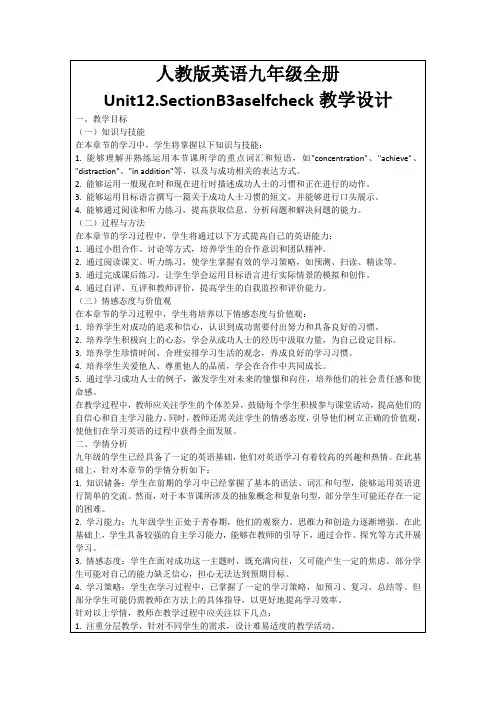
Unit 12 Life is full of the unexpected.Section A 1a-2d 教学设计内容分析本课是人教版九年级第12单元的教学内容。
本单元主要学习如何讲述过去发生的事情。
能够理解过去完成时(past perfect tense),能正确使用有when, before, as, by the time引导的时间状语从句表示过去发生的事情。
话题是unexpected events,贴近学生生活实际,能引起学生的学习欲望。
Section A部分的中心话题是讲述发生过的意想不到的事情。
教学重点是让学生明白过去时态和过去完成时态的区别,并能运用这两种时态叙述过去发生的事情。
本课是一节听说课。
学习内容围绕女孩Mary因为晚起导致上学迟到等一系列后果。
本课是本单元的第一课时,在整个单元中起着话题导入的作用。
内容贴近学生的生活实际,所含功能句都是日常生活用语,因此课堂任务应侧重培养叙述的语言实践能力。
1a-1c用五福主题图片呈现了女孩Mary遭遇到的一系列意想不到的事件场景:睡过头、浴室被占用、跑步出门、错过校车和把书包落在家。
活动围绕这五幅图片,以看图说话、听力及对话展开是整个Section A 部分的基础。
这部分还引入了新的语法结构:过去完成时。
学情分析本节课的中心话题是围绕女孩Mary因为晚起导致一系列意想不到的事件。
在讲述过程中,when, before, as, by the time引导的时间状语从句用一般过去时态,这个时态由于是复习,学生易于掌握。
同时导入过去完成时,让学生了解过去完成时态描述过去某一时间或动作之前已经发生或完成的动作。
这是重点也是难点。
由于话题贴近学生生活实际,在学习的过程中,结合女孩Mary 的bad day的情景讲述,很容易激发学生的同感并引起其学习兴趣。
【教学目标】:1. 语言知识目标:(1)学生能掌握以下单词及短语:unexpected, by the time, backpack, oversleep, ring, give …a lift,(2)学生能够掌握过去完成时的结构和用法。
人教版《英语》(新目标)九年级Unit12“Life is full of the unexpected.”教学设计教材分析本单元是九年级Unit 12,单元授课时间接近初三上学期期末,话题材料是通过对过去事件的复述来让学生体会“生活充满意外”这一主题。
语法学习方面。
教材前几个单元都是对初一、初二语法知识的复习,本单元是对初二学习的现在完成时的升华,让学生学习过去完成时的用法。
虽然这一时态在初中考纲中的要求是学生了解即可,对运用性的要求不高,但为了帮助学生更好地理解发生在过去的事件之间的顺序关系,以及学会如何更有逻辑地去跟别人讲述过去发生的事,教师认为有必要对过去完成时进行讲解。
本单元的教学重点在于描述某件事的过程和人物的感受,以及学习相关的词汇、句型及文章结构。
根据教学课时的安排,本单元共6个课时,内容为教材的第89页至第96页,具体课时安排如下:第一课时Section A(la-2d)听说课第二课时Section (3a-3c)阅读课第三课时Section A(Grammar Focus-4c)语法课第四课时Section B(la-1e)听说课第五课时section B(2a-2e)阅读课第六课时Section B(3a-Self-Check)写作课学情分析接近初三上学期期末,学生心态上已经有中考复习的心理准备,所以在学习过程中会自动将学习与考试相连接。
本单元的学习一方面关注阅读方法的训练,另一方面是写作的积累和练习。
同时,在紧张的氛围中学习一些过去的“意外事故”和“愚人节故事"等可以减轻学生学习的疲惫感和反感。
学习不大认真的同学也能通过本单元的学习找到一点乐趣,能轻松愉快地为期末考试作复习准备。
模块教学目标本单元涉及人与自我、人与社会的主题语境,描述过去事件的语篇主要以记叙文为主,根据《义务教育英语课程标准(2011年版) 》和《普通高中英语课程标准(2017版) 》对英语学习内容的设计,教师设计本单元的教学目标,旨在培养学生英语学科核心素养。
Unit 12 Life is full of the unexpected.Section A 1a-2d 教学设计内容分析本课是人教版九年级第12单元的教学内容。
本单元主要学习如何讲述过去发生的事情。
能够理解过去完成时(past perfect tense),能正确使用有when, before, as, by the time引导的时间状语从句表示过去发生的事情。
话题是unexpected events,贴近学生生活实际,能引起学生的学习欲望。
Section A部分的中心话题是讲述发生过的意想不到的事情。
教学重点是让学生明白过去时态和过去完成时态的区别,并能运用这两种时态叙述过去发生的事情。
本课是一节听说课。
学习内容围绕女孩Mary因为晚起导致上学迟到等一系列后果。
本课是本单元的第一课时,在整个单元中起着话题导入的作用。
内容贴近学生的生活实际,所含功能句都是日常生活用语,因此课堂任务应侧重培养叙述的语言实践能力。
1a-1c用五福主题图片呈现了女孩Mary遭遇到的一系列意想不到的事件场景:睡过头、浴室被占用、跑步出门、错过校车和把书包落在家。
活动围绕这五幅图片,以看图说话、听力及对话展开是整个Section A 部分的基础。
这部分还引入了新的语法结构:过去完成时。
学情分析本节课的中心话题是围绕女孩Mary因为晚起导致一系列意想不到的事件。
在讲述过程中,when, before, as, by the time引导的时间状语从句用一般过去时态,这个时态由于是复习,学生易于掌握。
同时导入过去完成时,让学生了解过去完成时态描述过去某一时间或动作之前已经发生或完成的动作。
这是重点也是难点。
由于话题贴近学生生活实际,在学习的过程中,结合女孩Mary 的bad day的情景讲述,很容易激发学生的同感并引起其学习兴趣。
【教学目标】:1. 语言知识目标:(1)学生能掌握以下单词及短语:unexpected, by the time, backpack, oversleep, ring, give …a lift,(2)学生能够掌握过去完成时的结构和用法。
新版人教版新目标九年级英语unitunit12-9教案课程简介本节课是针对九年级学生的英语教学内容,旨在帮助学生掌握单词、句型和语法规则,提高他们的听说读写能力。
教学目标- 通过本节课的研究,学生能够掌握本单元的重点词汇和短语。
- 学生能够在日常生活中正确运用所学到的语言知识。
- 学生能够通过各种听、说、读和写活动来提高他们的英语交际能力。
教学内容本节课主要包括以下内容:1. 单词和短语的研究:通过听、说和读的活动来帮助学生记忆和理解本单元的重点词汇和短语。
2. 句型和语法的研究:通过示范和练,帮助学生掌握本单元的重点句型和语法规则。
3. 听力和口语训练:通过听力和口语练,提高学生的听力理解和口语表达能力。
4. 读写训练:通过阅读和写作活动,提高学生的阅读理解和写作能力。
教学步骤1. Warm-up活动:通过一个有趣的小组讨论活动引入本节课的主题。
2. 单词和短语研究:通过展示图片和听力活动,引导学生研究和记忆本单元的重点词汇和短语。
3. 句型和语法研究:通过示范和练,帮助学生理解和掌握本单元的重点句型和语法规则。
4. 听力和口语训练:通过多种听力和口语练活动,提高学生的听力理解和口语表达能力。
5. 读写训练:通过阅读和写作活动,提高学生的阅读理解和写作能力。
6. 总结和复:通过互动讨论和小组活动,巩固学生对本节课内容的理解和掌握。
教学评估在本节课的各个环节中,教师将利用提问、点名、小组讨论等方式对学生进行评估,以确保他们掌握了本单元的重点知识和能力。
教学资源- 课本:新版人教版新目标九年级英语教材- 纸张、笔、图片等教具延伸活动为了帮助学生巩固和拓展所学的内容,可以进行以下延伸活动:- 邀请学生在家中进行有关本单元主题的自主研究和练。
- 利用多媒体资源和互动游戏增加研究的趣味性。
总结本节课的教案旨在帮助学生掌握新目标九年级英语unit 12-9的相关知识和能力。
通过多种教学方法和活动,学生将能够有效地学习和运用所学的语言知识,提高他们的英语交际能力。
首备人授课人课题教学目标重点难点教学方法教学过程人教版新目标九年级英语Unit12 单元集体备课教案九年级组复备人课型授课时间授课班级Unit 12 Life is full of the unexpected.第一课时Section A (1a-2d)【知识目标】Important words:unexpected,backpack,oversleep,block,worker,aboveImportant phrases:by the time,go off,give sb.a lift,miss bothevents,full of the unexpected,be about to do sth.,stare indisbelief at,rise above the burning building,jump out of bedImportant sentences:(1)B y the time I got up,my brother had already gotten in the shower.(2)W hen I got to school,I realized I had left my backpack at home.(3)I was about to go up when I decided to get a coffee first.【能力目标】能用过去完成时叙述过去的事件。
【情感目标】通过学习使学生认识到生活中充满了许多出乎预料的事件,培养学生辩证地看待问题。
过去完成时的定义及基本结构。
导学互学Step 1 情景导入参考案例Teacher:For one or more times in our school times,we are late for school.Have youever been late for school?Can you tell me why?And what happened to you that day?Students:①Yes,I have been late for school once.Because…②I was nearly late for class one day and……环节说明:通过课前的一个师生问答互动引入新课的话题Step 2 完成教材1a-1c的任务【操作案例】1.要求学生翻开课本P89,迅速阅读1a 部分的内容。
school, she realized she had left her backpack at home. All these made her look stressed out.
Remind them to use the correct verb forms.
Step 2 Presentation
Ⅰ. 2a
1.Look at activity 2a on page 90,
and see what happened to Mary later in the morning. Pay attention to the four pictures.
Get them to guess the correct order of the pictures first.
2.Ask the students to listen to the
tape ,and number the pictures in the correct order.
3.Ask one or two children to tell their stories by describing the pictures according to their own order.
4.Check the answers and see who
have ever got the correct answers without listening.
Ⅱ 2b
1.Let the Ss fill in the blanks with the correct forms individually.
2.After they all finish writing, tell them to listen to the conversation and check their answers.
Ⅲ.2c
1.Get students to discuss in pairs, Complete the ending. offering language support if needed.
2.Tell each pair to write down
their ending,
Ⅳ. Grammar Focus
1.Draw a simple time line for each sentence to help students to understand the grammar focus. For example:
2.Ask the students to make sentences correctly using each form of the verbs in the box.
Step 3 Summary
1.Listening practice with the target language.
2.Use the correct verb forms to Guess the
correct
order of
the
pictures
first,
then
listen to
the
tape ,and
number the pictures,
next tell
their
stories by describing
the
pictures
according
to their
own order.
Fill in
the blanks
with the
correct
forms. and
then
listen
again an
check the answers.
Make up an
ending for
the story
and share
it with
their
partner.
完成不同
听力任
务,提高
学生听力
能力,注
意动词的
变化。
训炼学生
思维,巩。